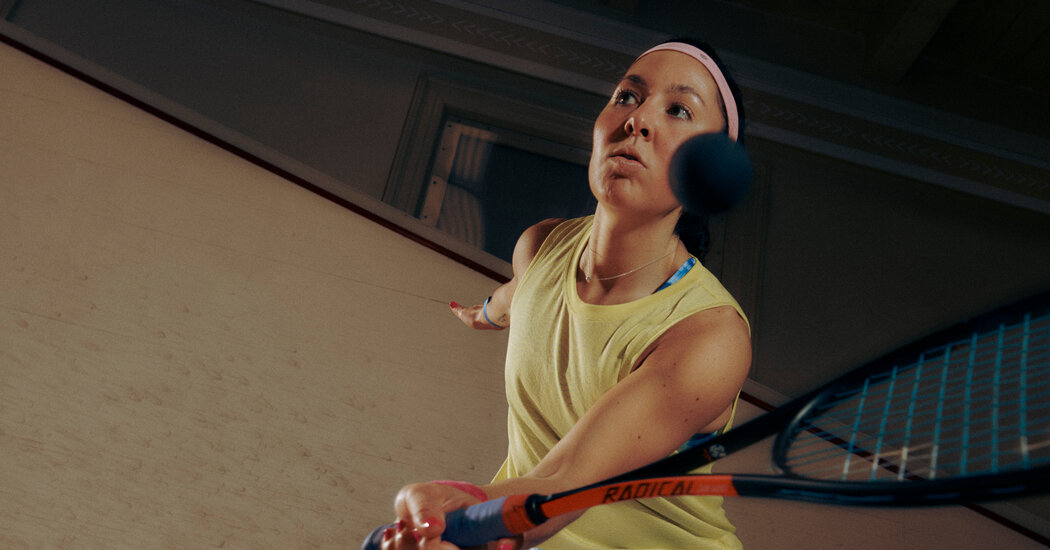
The Egyptians are renowned for their explosive play. Instead of the attritional British style, in which matches are won by running the opponent to exhaustion, the Egyptians look to end points quickly and with as much panache as circumstances allow. They were helped by an adjustment to the lower boundary on the front wall — it was reduced by two inches in 1990 for the men and in 2015 for the women — that spurred more risk-taking. The game still features plenty of lung-burning rallies, but there is much more action now in the front of the court — more drop shots and guileful flicks. John Nimick, a hardball pro in the 1980s, marvels at how the Egyptians have changed squash. “They have made it so kinetic, so angular, so fast, so creative,” he says.
Given Sobhy’s heritage and all the time that she spent in Cairo as a child, it is not surprising that she plays a similar style to the Egyptians, and as a pro, she has notched victories over all three women who are above her in the rankings: Nouran Gohar, Nour El Sherbini and Hania El Hammamy. But they are very difficult opponents. “I’ve played them and maybe the entire match they’ve given me one error,” Sobhy says. Consistency and judicious shot selection are paramount, and that’s where Sobhy sometimes runs into trouble. During her second match in Chicago, against the Welsh player Tesni Evans, ranked 14th, Sobhy won the first two games easily and held match points in the third. But she squandered them and ended up losing the third and fourth games before prevailing. (She was beaten in the next round, by world No. 5, Joelle King, of New Zealand.)
Sobhy is coached by Wael El Hindi, a former Top 10 player from Egypt who owns a racket club in Boynton Beach, Fla. She hired him in part because he “knows the mind of Egyptians.” El Hindi told me that he was working with Sobhy on developing a better sense of when to attack and when to pull back. The key for Sobhy, he says, is to be able to impose her game on opponents without taking excessive risks. What impresses him about Sobhy is her willingness to experiment. “She’s such a great student,” El Hindi says. “Even at her level, she’s open to learning things, to changing things.”
At the British Open in April, Sobhy showed signs of progress. In the quarterfinals, she defeated Fiechter 3-0 in 35 minutes. She was in total command from start to finish — no lapses, relentlessly aggressive without being reckless. The next day, she faced Gohar, the world No. 1. Sobhy had a winning record against the Egyptian but had lost their four most recent meetings. The victory over Fiechter left her feeling very confident, though. She might have drawn encouragement, too, from the fact that Paul Coll, a New Zealander, had just supplanted Ali Farag as the men’s top-ranked player — a crack in the Egyptian wall. “I thought I was ready,” she says.
Unfortunately for her, Gohar was in ruthless form. As hard as Sobhy hits the ball, Gohar seems to generate even more power, and the American quickly felt overwhelmed by her pace. “Instead of relaxing, I got very panicked, anxious,” she says. Gohar pounced on every loose shot, appeared to hit winners almost at will and took the match 3-0. Sobhy admitted to being “caught off guard” by how well her opponent played. “It had been a while since I had had such a poor loss on a grand stage,” she says.
But if the match showed that the gap between her and the best Egyptians is wider than she might wish, it also demonstrated the distance that Sobhy has traveled in other ways. She was crushed after the defeat and felt that old sense of shame and inadequacy — “my eating disorder voice,” as she puts it. She knew that spending the night alone in her hotel room was not a good idea. Instead, she went to visit some friends. By the following morning, Sobhy says, she was already strategizing about what she would do differently against Gohar the next time. In its own way, that felt like a victory.
Michael Steinberger is a contributing writer for the magazine. His last feature was about the billionaire Nicolas Berggruen and his think tank.